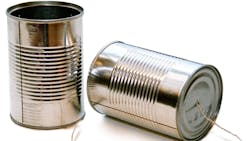Do you regularly communicate with your employees on the line or in the warehouse? Most companies don’t. Non-desk workers in a national study with large companies (more than 1,000 employees) reported receiving little to no communication from their corporate management over the course of a year.
The downside of leaving this employee population out of the loop is significant. That study indicated production workers and other non-office employees interpret the absence of communication as a lack of respect. But it can be done.
For instance, Bush Brothers—yes, the Bush’s Beans folks—saw a need to enhance employee communication, especially for manufacturing employees, and implemented a number of tactics including face-to-face CEO meetings and enhanced existing communications from managers to their direct reports. Imagine the pride and the payoff when those on the manufacturing floor literally get face time with the C suite on a regular basis.
Of course, communicating with non-desk employees isn’t easy because the communication channels and even scheduling (think “shifts”) can be different, but it can be done, as evidenced by both some well-known corporate brands and those that may be less familiar to you. The ones who are communicating with their manufacturing workforce know it provides a competitive advantage in terms of employee engagement.
The method might be high-tech or low-tech; what’s important is that it be in synch with the audience and that it is both used and effective. A metal manufacturer installed touch-screen kiosks on the shop floor. Employees know this is their centralized go-to source for communication. As you might imagine, a lot of thought goes into the content development and delivery for these kiosks because the company knows if the communication is not current, true and clear, employees will stop visiting.
Conversely, a division of Sara Lee Food recognized that much of its manufacturing workforce did not have computer access or use the Internet, but it very much needed to address key issues like company benefits online. So Sara Lee’s HR team deploys reps into the field helping their colleagues manage benefits.
When manufacturing employees understand management’s vision for the company, when they understand leadership’s business objectives, and when they feel respected and valued by corporate, they can be more effective and productive employees.
And a company need not re-invent the wheel to address communicating directly and effectively to line workers. As you might imagine, there is not only existing guidance out there but also off-the-shelf tools, like apps especially made for manufacturers to take their communication onto the mobile devices employees may already have for personal use. Yes, there are investments to be made and HR issues to be dealt with, but the costs are minimal: You're leveraging communication devices your employees already have.
Or maybe you bite the bullet and make the investment. When a new generation took over the family-owned S&W Manufacturing, the company was not in the best shape, so one of the investments the new leadership made was to ensure that employees had not only the best and latest manufacturing equipment but also the latest high-tech communication devices. S&W bought the communication tools that it saw employees needed: a win-win.
Reaching Non-Desk Workers
You’ll probably still need to develop a plan to reach those employees who don’t use mobile devices or who aren’t sitting in front of computers all day.
Four tactics for reaching non-desk workers:
Loop Them In: Commit to at least one channel through which non-desk employees will hear from management. This could be a town hall meeting via video for manufacturing employees, a recorded message accessed through an 800 number, or even a quarterly letter from the CEO mailed to employees’ homes. Sony Electronics is one company that has effectively held town hall meetings and CEO dialogues to facilitate direct communication with employees.
Ask Them What They Think: Having corporate management talk to this audience is a good step, but you also need to create opportunities for these employees to share their comments and views. Two-way communication methods—from the ability to comment on company changes to soliciting ideas for improving systems and processes—demonstrate management’s respect and the desire to understand the realities of these employees’ jobs. In some parts of the company Sony has top executives hold lunch meetings and quarterly off-site meetings so employees can literally communicate with the top. Likewise, at Nissan, employees regularly meet to discuss quality issues. Who better to tell you about your products’ quality than the people who build them?
Make Them Heroes: Spotlight manufacturing workers and celebrate their contributions through regular biographical pieces in a company publication, recognition programs or contests that highlight employee performance. (And make sure they see the publications in which they are featured!) Frito-Lay systematizes companywide sharing of field news to make accomplishments known and instill pride in the field.
Take the CEO to the People: Again, there is no substitute for giving employees a chance to meet face-to-face with top management, and this can be particularly meaningful to manufacturing employees. Look for opportunities to have members of your leadership team visit plants and other facilities and rub elbows with the people doing your company’s most important work. The Bush’s example above personifies that approach.
For a white paper on the survey referenced, see “Communicating with Non-Desk Workers” at www.tribeinc.com/bestpractices.
Elizabeth Cogswell Baskin is CEO and executive creative director of Tribe Inc. (www.TribeInc.com), an internal communications agency that develops strategic plans and designs creative vehicles to build employee engagement and the internal brand. She blogs on employee engagement, professional performance and quality of work-life at www.GoodCompanyBlog.com.
